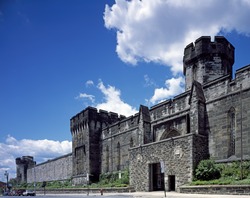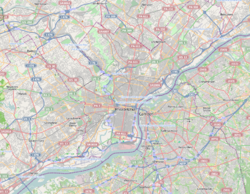Eastern State Penitentiary
|
Eastern State Penitentiary
|
|

The exterior of Eastern State Penitentiary.
|
|
| Location | 2027 Fairmount Avenue Fairmount, Philadelphia, Pennsylvania, United States |
|---|---|
| Area | 11 acres (45,000 m2) |
| Built | 1829 (closed in 1971) |
| Architect | John Haviland |
| Architectural style | Gothic Revival |
| NRHP Reference # | 66000680 |
| Significant dates | |
| Added to NRHP | October 15, 1966 |
| Designated NHL | June 23, 1965 |
| Designated PHMC | May 02, 1996 |
The Eastern State Penitentiary, also known as ESP, is a former American prison in Philadelphia, Pennsylvania. It is located at 2027 Fairmount Avenue between Corinthian Avenue and North 22nd Street in the Fairmount section of the city, and was operational from 1829 until 1971. The penitentiary refined the revolutionary system of separate incarceration first pioneered at the Walnut Street Jail which emphasized principles of reform rather than punishment.
Notorious criminals such as Al Capone and bank robber Willie Sutton were held inside its innovative wagon wheel design. James Bruno (Big Joe) and several male relatives were incarcerated here between 1936-1948 for the alleged murders in the Kelayres Massacre of 1934, before they were pardoned. At its completion, the building was the largest and most expensive public structure ever erected, and quickly became a model for more than 300 prisons worldwide
The prison is currently a U.S. National Historic Landmark, which is open to the public as a museum for tours seven days a week, twelve months a year, 10 am to 5 pm.
Designed by John Haviland and opened on October 25, 1829, Eastern State is considered to be the world's first true penitentiary. Eastern State's revolutionary system of incarceration, dubbed the "Pennsylvania system" or separate system, encouraged separate confinement (the warden was legally required to visit every inmate every day, and the overseers were mandated to see each inmate three times a day) as a form of rehabilitation.
The Pennsylvania System was opposed contemporaneously by the Auburn system (also known as the New York system), which held that prisoners should be forced to work together in silence, and could be subjected to physical punishment (Sing Sing prison was an example of the Auburn system). Although the Auburn system was favored in the United States, Eastern State's radial floor plan and system of solitary confinement was the model for over 300 prisons worldwide.
...
Wikipedia



